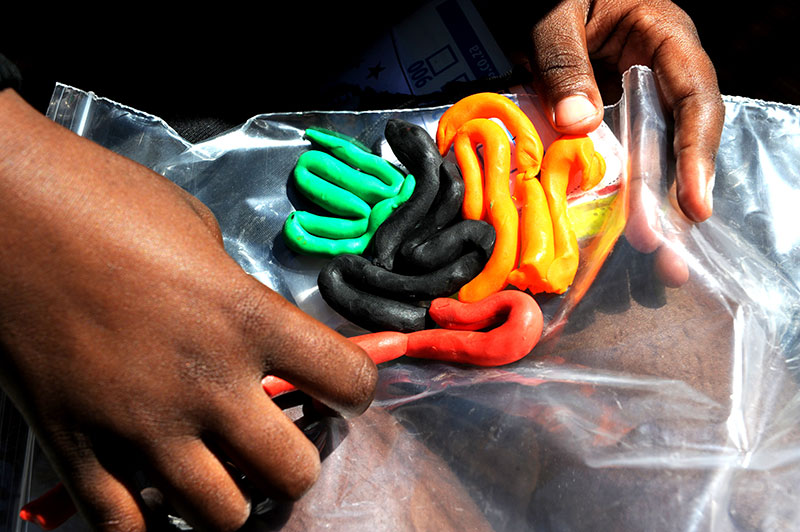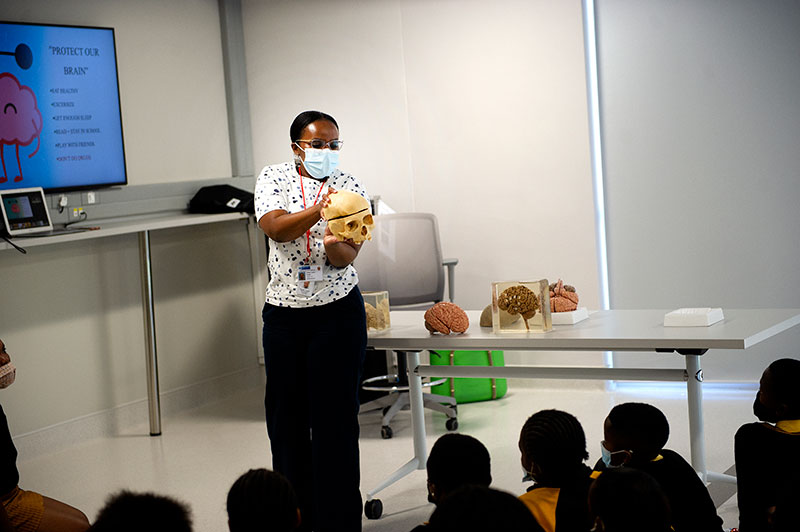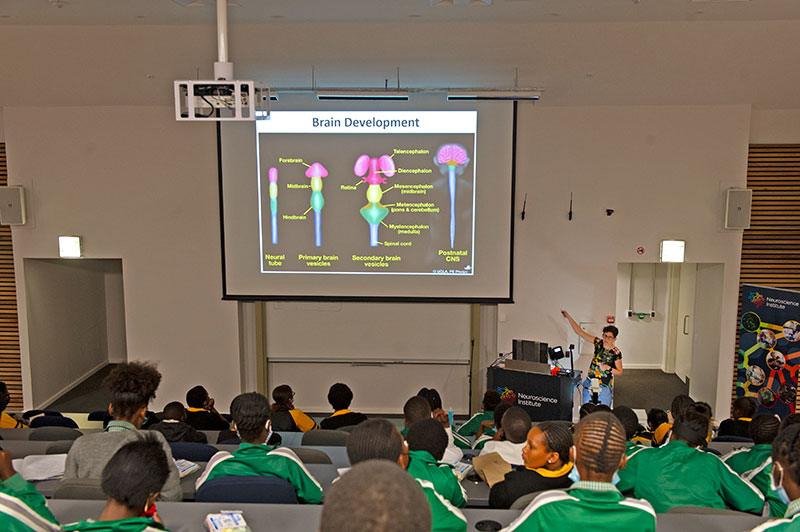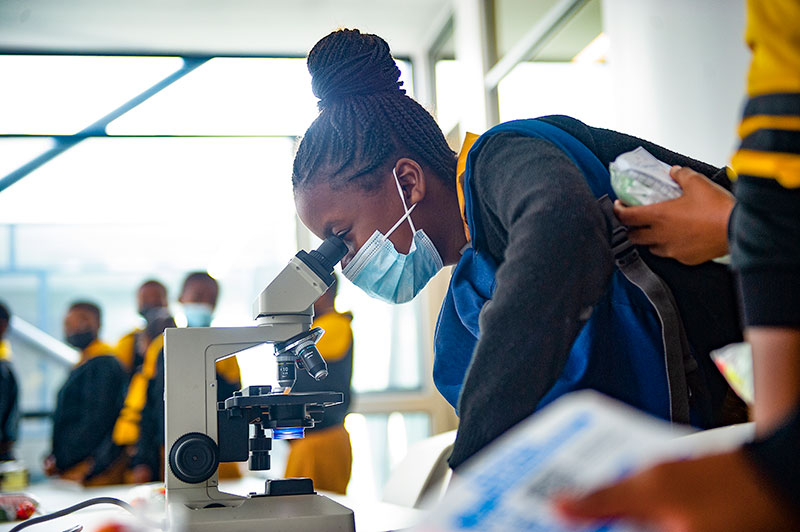Date with a dancing cockroach
22 March 2022 | Story Helen Swingler. Photos Lerato Maduna. Voice Cwenga Koyana. Read time 8 min.
Fifty-six Mfuleni Grade 7 learners will likely never forget the sight: a cockroach leg moving to the beat of “I like to move it, move it”. Wonder, disbelief and hilarity lit up the lecture theatre as Associate Professor Joe Raimondo demonstrated how neural electrical impulses make bodies move, work – and dance. And this was hip-hop, ’roach style.
The learners were from Bardale and Itsitsa primary schools. The setting was the University of Cape Town’s (UCT) Neuroscience Institute. The occasion: International Brain Awareness Week from 14 to 20 March. The aim: to inspire a dream and a new generation of neuroscientists, said organiser Dr Ursula Rohlwink.
Associate Professor Raimondo’s demonstration showed why the brain is the body’s most important organ and how electrical impulses emanating there – travelling at lightning speed through the body – are key to keeping busy bodies moving.

First, Raimondo’s young volunteer from Bardale Primary School allowed a live Madagascar hissing cockroach, a ferocious-looking though harmless creature, to roam her hand – eliciting exclamations from her peers. And then, guided by Raimondo, she carefully clamped tiny electrodes to a dissected cockroach leg. Raimondo pumped up the music. And the specimen slowly started moving…
Brain waves
The programme was designed to expose the learners to a range of neuroscience topics, experts, and varied experiences, said Dr Rohlwink, a clinical neuroscientist whose research focuses on brain injury due to trauma and infection.
“We focused on conditions that are prevalent in poorer communities, including brain trauma, infection and substance abuse.”
“We talked about how the brain works (its electrical nature) and how it develops, and then followed these foundational talks with ones that dealt with physical injury to the brain and mental health. For these we focused on conditions that are prevalent in poorer communities, including brain trauma, infection and substance abuse.”
Rohlwink added, “We wanted to stress that there are ways in which these conditions can be managed and treated. All the talks touched on how the children can maintain their brain health, and this was the particular focus of the talk on sleep.”
Microscopic to macroscopic
First, neuroscientist Dr Rachael Dangarembizi showed them what the brain looks like under the microscope, followed by paediatric neurosurgeon Dr Nqobile Thango, who gave learners a macroscopic, hands-on view of the different areas of the brain and how the skull is designed to protect this sensitive organ.
After Raimondo’s demonstration, cell biologist Dr Dorit Hockman showed how brains develop in embryonic chicks. After gently sucking out some of the albumin with a syringe and carefully incising the eggshell (fortified by thick Sellotape), Dr Hockman stained the yolk with blue ink to highlight the fledgling brain and neural tube. Here again, learners saw a researcher at work with commonly used tools: scalpel, stains and syringes.
Comparative neuroanatomist Dr Adhil Bhagwandin spoke about the importance of rest for the development of healthy brains and the regulation of mood and behaviour. For this, healthy brains need oxygen, glucose and enough quality sleep for healthy development and to perform optimally, the learners heard.

Dr Bhagwandin compared sleep patterns in a variety of animals and how their sleep duration and patterns are adapted to their habitats and survival. The young audience was enthralled to hear that whales and dolphins sleep with half of their brains alert at any one time; half of their brain “shuts down” while the other half remains active.
Before lunch, it was time for the learners to get creative, outside in the sunshine, modelling parts of the brain with blocks of brightly coloured clay. This part of the programme was organised by the UCT student-led Cortex Club, an educational forum devoted to cutting-edge topics and challenging issues in neuroscience.
Mental health and substance abuse were tackled by Dr Nynke Groenewald and Dr Freda Scheffler, who also introduced the learners to the many help lines and resources available to them as young adults facing myriad different social and economic pressures.
Planting a seed
At the end of the day, learners told Rohlwink that they would never forget the experience. This is critical to its aim, said Rohlwink, who started this outreach programme in 2019 with a hugely successful event hosting 83 learners from Capricorn Park School. The programme targets learners from resource-constrained communities and hopes to plant a seed in future neuroscientists.
“The idea of planning this to coincide with International Brain Awareness Week [14–20 March] seemed a perfect fit.”
COVID-19 stymied this outreach in 2020 and 2021. But this year Rohlwink was determined to get the ball rolling again and partnered with the Yabonga Foundation. This organisation provides after-school and mentoring support for children and works with numerous schools in various townships, including Mfuleni.

“The foundation was founded by Ursel Barnes and Ulpha Robertson. Ursel, together with her husband, David, is one of the key philanthropic funders of the Neuroscience Institute and a strong supporter of growing neuroscience in Africa,” said Rohlwink.
“I am hoping that we will grow our collaboration with Yabonga in the planning of future events.”
The event was funded through Rohlwink’s Crick African Network Career Accelerator Grant, which is funded by the Francis Crick Institute in the United Kingdom.
“They strongly supported the role of outreach in creating community awareness about my research field of brain injury and infection,” she said.
Vision 2030
The programme also links directly to UCT’s Vision 2030 and the pillars of sustainability, transformation and excellence.
“The aim is definitely to inspire the next generation of neuroscientists, but more broadly we hope to expose these children with limited opportunities to the wonders of the brain, to provide them with knowledge on how to protect and maintain the health of their developing brains, and to show them the exciting world of science and research. We selected this [age group] as they will soon embark on high school when they make subject choices that will impact the careers they can choose.”

Important here is that presenters came from neurosurgery, clinical neuroscience, basic neuroscience, neuroanatomy and psychiatry, and their varied skills and expertise offered a diversity of experiences in the talks from didactic lectures to practical demonstrations and varied content, Rohlwink said.
“We were also aware of offering a speaker panel that was diverse in terms of demographics and gender so that the students could relate to speakers and possibly identify with them.
“If we get just one of these learners coming to study neuroscience at UCT, it will have been worth it!”
 This work is licensed under a Creative Commons Attribution-NoDerivatives 4.0 International License.
This work is licensed under a Creative Commons Attribution-NoDerivatives 4.0 International License.
Please view the republishing articles page for more information.
Listen to the news
The stories in this selection include an audio recording for your listening convenience.











































































































































































































































































































































































































